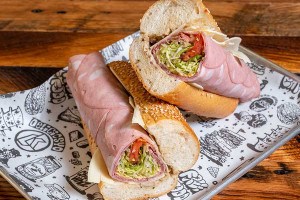The Mystery of “Vegetable Charcuterie” at Vedge
We tried to give ourselves the benefit of the doubt. We really did. But after reading no fewer than four undefined references to “vegetable charcuterie” in the local food press’ coverage of the soon-to-open vegan restaurant Vedge, we realized we’d screwed up.
Honestly, when we here at Foobooz printed it, we didn’t stop to think about the unlikelihood of anyone knowing what vegetable charcuterie is. Hell, we’re not even sure we know what vegetable charcuterie is. As far as we know, everyone on the planet assumes charcuterie is meat. Seriously, we eat it at every single farm-to-table restaurant in town, every rustic Italian trattoria and New American bistro, and each time that charcuterie plate comes out, by God, there is meat on it. Good, old-fashioned animal flesh–salted, cured, smoked and delicious.
But Vedge co-owner Rich Landau listed “vegetable charcuterie” as an upcoming menu item in a release he sent us in June and we published it. We admit to our excessive (choose one of more of the following): credulity/deadline pressure/laziness/willful suspension of disbelief. But now we challenge the men and women behind the curtains at The Inqui, Grub Street (who printed the term again Monday in a roundup of restaurants to look forward to) and City Paper (who at least put “charcuterie” in quotation marks) to do the same.
Sometimes we food writers lose sight of the basic requirement of our job description: to communicate effectively with readers. We may get to brag at cocktail parties about the time we nibbled on vegan charcuterie at Gather in Berkeley (which is where Landau first came across the term and which is one of the only restaurants in the country to serve the dish), but we can’t forget that most Philadelphians haven’t had that opportunity. Or that most food writers haven’t either. So if we’re paying attention, we Google the phrase and, finding only one or two descriptions on the whole Internet, we define it for you. If we’re not paying attention, we print it verbatim and head out to happy hour–a phrase that everyone understands, food writers in particular.
What’s ironic here is that when I called Landau to laugh this over, he good-naturedly said, “We’re trying to reach the ‘raise-the-eyebrows’ crowd. We want to convey the level of sophistication of vegetables by honing in on the art and technique of preparing them. We’re not doing anything here that’s going to instantly be made fun of.”
Well, Rich, you got it. None of us made fun of the fact that you’re converting a quintessential meat dish into rabbit food. None of us explained it with an example, like your portobello mushroom carpaccio roasted with a spice rub, sliced ultra thin then lightly smoked over applewood chips.
And especially, none of us told your potential patrons anything like this: In the forward to the cookbook Charcuterie: The Craft Of Salting, Smoking, And Curing, Thomas Keller explains in the foreword, “Charcuterie … originally referred to the creation of pork products such as salami, sausages, and prosciutto. … Today the term encompasses a vast range of preparations, most of which involve salting, cooking, smoking, and drying. In addition to providing classic recipes for sausages, terrines, and pates, [authors] Michael Ruhlman and Brian Polcyn expand the definition to include anything preserved or prepared ahead such as Mediterranean olive and vegetable rillettes … pickles and sauerkraut.”
So “vegetable charcuterie”? It’s a thing. It isn’t (as we’ve been joking for the past couple days) just a bunch of sliced veggies on a plate with some ranch dressing. And now that we know a little more about it, we’re actually a little bit intrigued.
Can we leave for happy hour yet?

